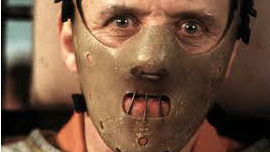Serial Killer is the New Cowboy

Looking over the summer blockbuster movies I see that “The Lone Ranger” flopped. The western, that iconic American genre, seems to be on the wane. Post-modern treatments, or westerns with twists (“Brokeback Mountain”; “Unforgiven”), attract an audience and/or admiration, but the straight up, unironic, unreconstituted, cowboy narrative feels anachronistic.
It seems to me that the Serial Killer is the heir apparent to the Cowboy as the 21st-century cinematic embodiment of tumescent, hyper-extended American individualism. Like the cowboy, the serial killer both troubles and fascinates.
Hannibal Lecter in “The Silence of the Lambs” sets the standard for the monster-hero serial killer (who often spawns serial movies and sequels as well). Other examples can be found in “Seven,” “Scream,” “American Psycho,” the Major Holiday Slasher Flicks, “The Lovely Bones,” and more. Cable and network series include the acclaimed and popular “Dexter,” as well as a share of the crime procedural dramas.
Obviously, there are vastly more serial killers as a percentage of Hollywood characters than there ever are in real life, violent though our country may be. Sadly, and to indirectly support my assertion, I find myself having to underscore the actual rarity of serial killers to my son far too often.
A quick Ngram search of content corroborates the inversely declining and rising narrative fortunes of “cowboy” and “serial killer,” respectively. (Ngram has problems, to be sure, but it’s an interesting metric and snapshot of trends). The term serial killer is a recent, mid to late-20th century coinage. Although the subject of the cowboy hearkens to the 1870s, the term reached peak popularity retrospectively, in the late 1930s. It’s been on the decline since the 21st century began. While still not as common as cowboy, serial killer has been trending meteorically since the start of the 21st century, although the data only go to 2008. Since then, the serial killer’s panache has only grown.
The lineage isn’t precise by any means, since the cowboy and/or gunslinger, while very much his own man, had a claim to white hat heroism and honor that the serial killer lacks. While a cowboy might kill, the serial killer only kills, and wears only the black hat—although he’s delighted over in the movies, all the same, and makes up in glamour what he lacks in honor.
The cinematic serial killer, like the cowboy of yore, roams the country alone, as a law unto himself. Neither is constrained, or protected, by laws, custom, or concepts of justice. The serial killer takes what he wants with the ultimate disregard for others, stretching atavism and self-determination just as far as they can possibly go. He embodies the nightmare (and the secret, troubling thrill) of a world of nothing but hyper-individualists in a fight to fulfill their desires, however grotesque they may be.
The serial killer is the monstrosity and abnormality that grows out of normal, laudatory convictions—in this case, of unbridled freedom, liberty, and individualism.
Like the cowboy of yore, the cinematic serial killer usually has some vigilante standard for his actions. He always has reasons for what he does that go beyond cruelty, sociopathy, greed, and madness (ie, Seven, or Hannibal Lector’s choices of victims as explained in The Silence of the Lambs). Or, if he has no private “code of justice” that dictates when, why, and how he kills, then at least the Hollywood serial killer has taste, style, and a gorgeous physique, which occasionally substitute in America for a moral code or philosophy.
Just as no one likes a poor, unpropertied sadist in popular literature—have you ever known one to succeed who wasn’t landed or filthy rich?—no one likes a witless, tasteless, overweight serial killer.
In this regard, Hollywood takes tremendous poetic license. “The thing about criminals is, they’re dumb,” explains a lawyer acquaintance of mine. Or crazy. Or both dumb and crazy. They usually get caught because of these two characteristics.
Libertarian heroine Ayn Rand was fascinated by an early serial killer, William Hickman. She came by her gruesome preoccupation honestly, and ingenuously. Like Rand’s imagined subject, the serial killer inhabits a cold, ruthless world where the individual must survive or languish on his own. Her fascination isn’t to say that she found him admirable, per se (although some claim that she did) but simply the disturbing terminus of her own logic. Like a tumor, the serial killer was the monstrous thing created—and perhaps inevitably– by the gross proliferation of what she thought to be otherwise non-monstrous, normal ideals.
The normative values of any society spawn their own caricatured monsters and heroes or, in some cases, hybrid monster-heroes in fiction about whom we’re undecided. They raise the “what if” extreme fringe of common beliefs… what if… every single individual acted only as an individual, and did only what they desired to do… what if… we were all maximally, unrestrainedly, if monstrously, self-realized and determined? The cowboy used to play with some of that tension. Now, it’s the serial killer. As I find myself thinking about our young century quite often, and to quote The Who, “it’s a hard hard world.”




